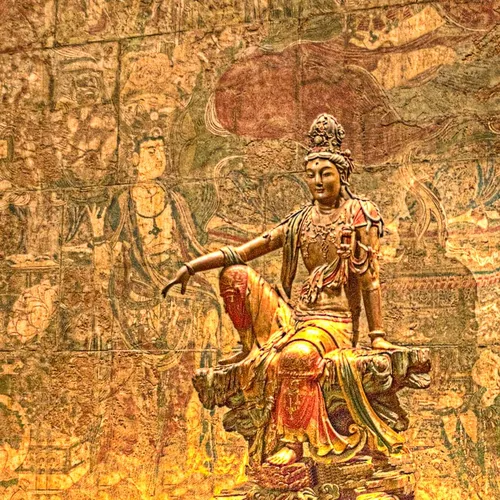
Fall 2013 Shamatha and the Seven-Point Mind Training
Alan Wallace Fall 2013 8-Week retreat on Shamatha and the Seven-Point Mind Training.
This retreat was held at the Thanyapura Mind Centre in Phuket, Thailand, from September 2nd - October 28th, 2013
- Update frequency
- every day
- Episodes
- 94
- Years Active
- 2013

73 Awareness of awareness
We lock onto an object, reify it and then attachment or aversion arises. The discovery model allows the mind to heal itself by doing nothing but maintaining cognizance.
Discussion of blessings ari…

72 The Mahayana teaching on transferring consciousness is precisely these five powers...
Alan again front loads the meditation by comparing Atisha's Lam Rim texts and Seven Point Mind Training text and the role of discursive meditation in both. We can be encouraged that although Ultimate…

71 Return to Awarness of Awareness or Shamatha Without a Sign
Alan front loads this session by looking at the difference between this practice and Dzogchen - grasping - and looks at how practice is ideally couched in a supportive way of life. After the meditati…

70 Practice of the stage of generation of Avalokiteshvara
Today's evening session begins with the continuation of the discussion on the power of prayer and blessings. Alan gives a few examples of how blessings work and their possible bandwidth and draws ana…

69 Settling the mind in its natural state
This morning we start with the last session in the second cycle of settling the mind in its natural state. Alan gives a short preamble before we go into a silent meditation emphasizing the utter simp…

68 The Positive and Negative Aspects of Modern Science and the Future of Contemplative Inquiry in All Religions
Before the guided meditation, Dr. Wallace comments on Malala, a 16 year old girl from Pakistan, who currently fights for the right of education for women amidst Taliban death threats against her.
Aft…

67 Settling the Mind in Its Natural State
Before the meditation, Dr. Wallace starts with a prelude to the meditation of settling the mind in its natural state. The focus should now be on the ongoing flow of mindfulness, whether thoughts and …

66 Ultimate and Relative Bodhicitta meditation and scientific evidence
Silent meditation session and then a continuation of yesterday's theme related to the 'power of prayer'. "We don't believe in anything without sufficient evidence". That's the creed of scientists and…

65 Settling the mind in its natural state and achieving Shamatha
We revisit an important facet of settling the mind in its natural state: to observe not so much the objective appearances to the mind, but the subjective impulses to the mind. This is not as easy as …

64 Ultimate and Relative Bodhicitta meditation and the 'power of prayer' from the text
Silent meditation on relative and ultimate Bodhicitta (not recorded) at 6:08.
Fourth point of the text 'To synthesise the essence of this practical guidance, apply yourself to the five powers', the …

63 Settling the mind in its natural state and the 9 stage of shamatha
Focus simply on the observation of the so call objective appearances that appear in the space of the mind.
When we have difficulty doing this practice, the way to counter is to learn to relax more…

62 Meditation uniting ultimate and relative Bodhicitta
Meditate for half the session on shamatha without a sign – probing right into where you think the observer is – this can lead to ultimate Bodhicitta. Spend the second half of the session on Tonglen,…

61 Settling the mind in its natural state
What makes us so vulnerable to suffering? We identify so closely with the body and mind. This meditation starts to put some distance as you roll back from the environment, roll back from your body an…

60 Whatever you encounter immediately apply it to meditation
Here Alan continues the Lojong text and addresses how we can eliminate the tug of war between dharma and our everyday life by transforming everything into dharma. We look at different ways of viewing…

59 Return to Settling the Mind
We return to this practice also known as Appearances and Awareness as the Path. Alan reminds us to examine the essential nature of the thought arising rather than the content or referent and discusse…

58 Tong Len meditation and The Seven Point Mind Training
We begin the evening session with a silent Tong Len meditation by focusing on a person, group of people, or other sentient beings - those who come to mind. The session is briefly introduced by Alan r…

57 Mindfulness of breathing and the sixth stage ofthe Shamatha path
The morning session starts with a silent meditation on mindfulness of breathing of our preferred mode (not recorded). After the meditation, stage six of the Shamatha path is commented, which is: paci…

56 Continuation of commentary of "Scientific View" from 17th Century (Thomas Sprat) to nowadays
After el short introduction, we go into a silent meditation session on the three spaces.
Right after the meditation, we go back to the theme of the "spirits". Alan talks about how scientific studies,…

55 Mindfulness of Breathing
The morning session starts with a footnote on the subject of yesterday's evening session, i.e. spirits. Then we continue with a silent meditation on mindfulness of breathing (not recorded). After th…

54 Three spaces meditation and the four practices
Again returning to the three space meditation, this time front loaded with a readings from the Bāhiya Sutta and instruction from Sera Khandro Dewé Dorje, an accomplished yogini. Also references to th…